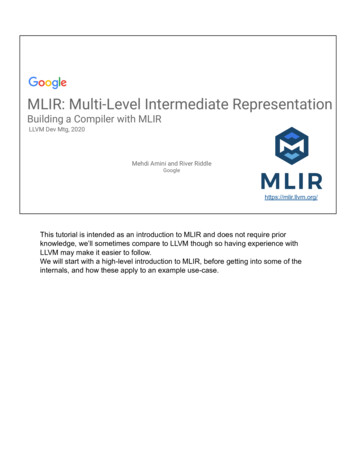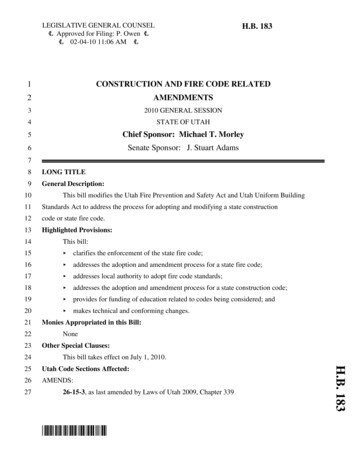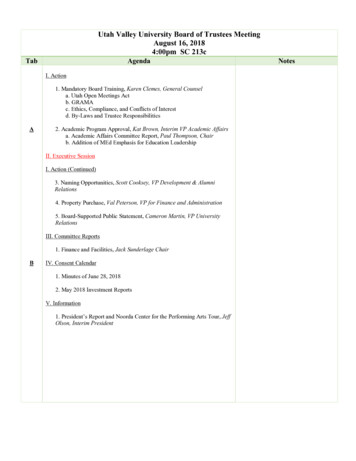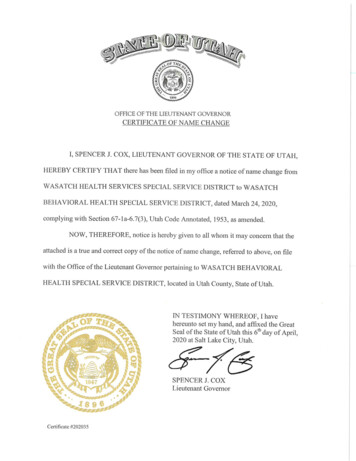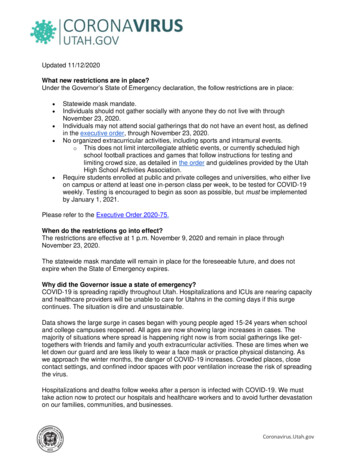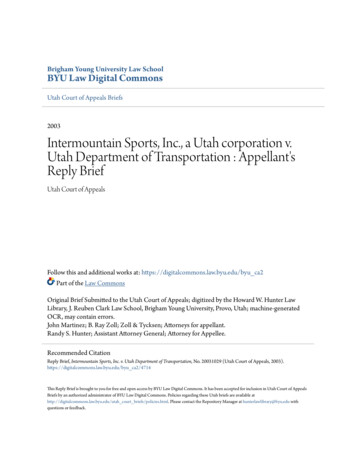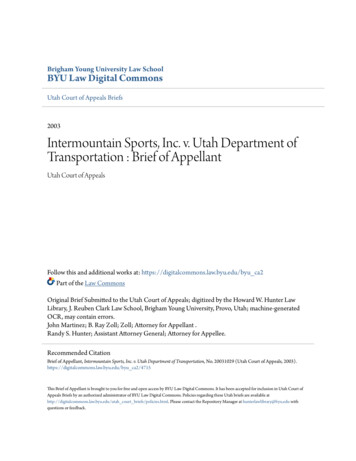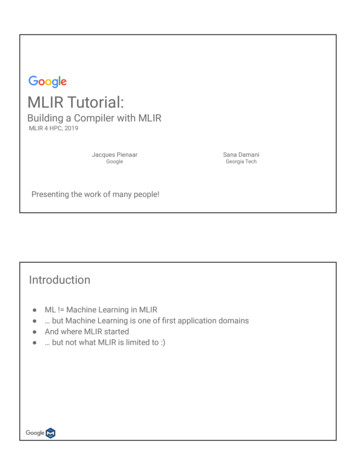
Transcription
MLIR Tutorial:Building a Compiler with MLIRMLIR 4 HPC, 2019Jacques PienaarSana DamaniGoogleGeorgia TechPresenting the work of many people!Introduction ML ! Machine Learning in MLIR but Machine Learning is one of first application domainsAnd where MLIR started but not what MLIR is limited to :)
Why a new compiler infrastructure?The LLVM Ecosystem: Clang CompilerC, C , ObjC,CUDA, OpenCL, .Clang ASTLLVM IRare SSA IRs:Different levels of abstraction - operations and types are differentAbstraction-specific optimization at both levelsGreen boxes Machine IRProgressive lowering: Simpler lowering, reuse across other front/back endsAsm
Azul Falcon JVMJava & JVMLanguagesJava BCC, C , ObjC,CUDA, OpenCL, .Clang ASTLLVM IRMachine IRAsmUses LLVM IR for high level domain specific optimization: Encodes information in lots of ways: IR Metadata, well known functions, intrinsics, Reuses LLVM infrastructure: pass manager, passes like inliner, etc.“Falcon: An Optimizing Java JIT” - LLVM Developer Meeting Oct’2017Swift CompilerSwiftJava & JVMLanguagesJava BCC, C , ObjC,CUDA, OpenCL, .Clang ASTSwift ASTLLVM IRMachine IRAsmSIL IR3-address SSA IR with Swift-specific operations and types: Domain specific optimizations: generic specialization, devirt, ref count optzns, library-specific optzns, etc Dataflow driven type checking passes: e.g. definitive initialization, “static analysis” checks Progressive lowering makes each edge simpler!“Swift's High-Level IR” - LLVM Developer Meeting Oct’2015
A sad aside: Clang should have a CIL!Java & JVMLanguagesC, C , ObjC,CUDA, OpenCL, .SwiftJava BCClang ASTCIL IRSwift ASTSIL IRLLVM IRMachine IRAsmMachine IRAsm3-address SSA IR with Clang-specific operations and types: Optimizations for std::vector, std::shared ptr, std::string, Better IR for Clang Static Analyzer Tooling Progressive lowering for better reuseAnyway, back to the talk.Rust and Julia have things similar to SILJava & JVMLanguagesC, C , ObjC,CUDA, OpenCL, . Java BCClang ASTCIL IRSwiftSwift ASTSIL IRRustRust ASTMIR IRJuliaJulia ASTJulia IRLLVM IRSoon Fortran withFIR too! (talk latertoday)Dataflow driven type checking - e.g. borrow checkerDomain specific optimizations, progressive lowering“Introducing MIR”: Rust Language Blog, “Julia SSA-form IR”: Julia docs
TensorFlow XLA CompilerJava & JVMLanguagesC, C , ObjC,CUDA, OpenCL, .Clang ASTCIL IRSwiftSwift ASTSIL IRRustRust ASTMIR IRJuliaJulia ASTJulia IRTF GraphXLA HLOTensorFlowEcosystem Java BCLLVM IRMachine IRAsmDomain specific optimizations, progressive lowering“XLA Overview”: https://tensorflow.org/xla/overview (video overview)Domain Specific SSA-based IRsGreat! High-level domain-specific optimizations Progressive lowering encourages reuse between levels Great location tracking enables flow-sensitive “type checking”Not great! Huge expense to build this infrastructure Reimplementation of all the same stuff: pass managers, location tracking, use-def chains, inlining, constant folding, CSE, testing tools, .Innovations in one community don’t benefit the others
The TensorFlow compiler ecosystemLLVM IRGrapplerXLA HLOTPU IRTensor RTSeveral othersTensorFlowGraphnGraphCore MLNNAPITensorFlow LiteMany othersMany “Graph” IRs, each with challenges: Similar-but-different proprietary technologies: not going away anytime soon Fragile, poor UI when failures happen: e.g. poor/no location info, or even crashes Duplication of infrastructure at all levelsGoal: Global improvements to TensorFlow infrastructureBut HPC has similarSSA-based designs to generalize and improve ML “graphs”:needs so why stop Better side effect modeling and control flow representationthere? Improve generality of the lowering passes Dramatically increase code reuse Fix location tracking and other pervasive issues for better user experienceNo reasonable existing answers! and we refuse to copy and paste SSA-based optimizers 6 more times!
What is MLIR?A collection of modular and reusable software componentsthat enables the progressive lowering of operations, toefficiently target hardware in a common wayHow is MLIR different?State of Art CompilerTechnologyModular & ExtensibleNot opinionatedMLIR is NOT just a commongraph serialization format nor isthere anything like itFrom graph representationthrough optimization to codegenerationChoose the level ofrepresentation that is right foryour deviceNew shared industryabstractions spanninglanguages ("OMP"dialect?)Mix and matchrepresentations to fitproblem spaceWe want to enablewhole new class ofcompiler research
A toolkit for representing and transforming “code”Represent and transform IR While enablingRepresent Multiple Levels ofCommon compiler infrastructure tree-based IRs (ASTs),graph-based IRs (TF Graph, HLO),machine instructions (LLVM IR)IR at the same time location trackingricher type systemcommon set of conversion passesAnd much moreWhat about HPC?Could talk about: reusing abstractions for parallelism (new parallelism constructs?),polyhedral code generationsstencil abstractionsInstead: here to listen what are the problems domain specific abstractions duringcompilation could lead to much simpler/better worldImprovements in one community benefiting others
Introduction: a Toy Language(e.g., enough talking, let’s get to code)OverviewTour of MLIR by way of implementing basic toy language Define a Toy languageRepresent Toy using MLIR Attaching semantics to custom operationsHigh-level language specific optimizations Pattern rewrite frameworkWriting passes for structure rather than ops Introducing dialect, operations, ODS, verificationsOp interfaces for the winLowering to lower-level dialects The road to LLVM IRThe full tutorial on the MLIRs GitHub
Let’s Build Our Toy Language Mix of scalar and array computations, as well as I/OArray shape InferenceGeneric functionsVery limited set of operators (it’s just a Toy language!):"template typename A, typename B, typename C auto foo(A a, B b, C c) { . }"def foo(a, b, c) {var c a b;print(transpose(c));var d 2, 4 c * foo(c);return d;}Value-based semantics / SSAOnly 2 builtin functions: print and transposeArray reshape through explicit variable declarationOnly float 64sExisting Successful ModelC, C , ObjC,CUDA, Sycl,OpenCL, .SwiftRustClang ASTSwift ASTRust ASTSILHIRMIRLLVM IRMachine IRAsmLLVM IRMachine IRAsmLLVM IRMachine IRAsm
The Toy Compiler: the “Simpler” Approach of ClangNeed to analyze and transform the AST- heavy infrastructure!And is the AST really the most friendlyrepresentation we can get?Shape InferenceFunction Specialization(“TreeTransform”)ToyLLVM IRToy ASTMachine IRAsmThe Toy Compiler: With Language Specific OptimizationsNeed to analyze and transform the AST- heavy infrastructure!And is the AST really the most friendlyrepresentation we can get?Shape InferenceFunction Specialization(“TreeTransform”)ToyToy ASTTIRLLVM IRHigh-LevelLanguage SpecificOptimizationsFor more optimizations: a custom IR.Reimplement again all the LLVM infrastructure?Machine IRAsm
Compilers in a Heterogenous WorldNeed to analyze and transform the AST- heavy infrastructure!And is the AST really the most friendlyrepresentation we can get?Shape InferenceFunction Specialization(“TreeTransform”)ToyHW Accelerator(TPU, GPU, FPGA, .)TIRToy ASTNew HW: are we extensibleand future-proof?"Moore’s Law Is Real!"LLVM IRMachine IRAsmMachine IRAsmHigh-LevelLanguage SpecificOptimizationsFor more optimizations: a custom IR.Reimplement again all the LLVM infrastructure?It Is All About The Dialects!MLIR allows every level to berepresented as a DialectShape InferenceFunction Specialization(“TreeTransform”)ToyToy ASTImplementedas DialectHW Accelerator(TPU, GPU, FPGA, .)TIRHigh-LevelLanguage SpecificOptimizationsMLIRLLVM IRImplementedas Dialect
Adjust Ambition to Our Budget (let’s fit the talk)Limit ourselves to a single dialect for Toy IR: still flexible enough to perform shapeinference and some high-level optimizations.Shape InferenceFunction Specialization(“TreeTransform”)ToyToyASTHW Accelerator(TPU, GPU, FPGA, .)LLVM IRTIR (Toy IR)Implementedas DialectHigh-LevelLanguage SpecificOptimizationsMLIRMLIR PrimerImplementedas DialectMachine IRAsm
Operations, Not Instructions No predefined set of instructionsOperations are like “opaque functions” to MLIRNumber ofvalue returnedDialectprefixOp IdArgumentIndex inthe producer’s resultsList of attributes:constant named arguments%res:2 "mydialect.morph"(%input#3) { some.attribute true, other attribute 1.5 }: (!mydialect "custom type" ) - (!mydialect "other type" , !mydialect "other type" )loc(callsite("foo" at "mysource.cc":10:8))Name of theresultsDialect prefixfor the typeOpaque string/Dialect specifictypeMandatory andRich LocationExamplefunc @some func(%arg0: !random dialect "custom type" ) - !another dialect "other type" {%result "custom.operation"(%arg0) :(!random dialect "custom type" ) - !another dialect "other type" return %result : !another dialect "other type" }Yes: this is a fully valid textual IR module: try round-tripping with mlir-opt!
The “Catch”func @main() {%0 "toy.print"() : () - tensor 10xi1 }Yes: this is also fully valid textual IR module!It is not valid though! Broken on many aspects: the toy.print builtin is not a terminator,it should take an operandit shouldn’t return any valueJSON of compiler IR ?!?Dialects: Abstractions, Rules and Semantics for the IRA MLIR dialect is a logical grouping including: A prefix (“namespace” reservation) A list of custom types, each its C class. A list of operations, each its name and C class implementation: Verifier for operation invariants (e.g. toy.print must have a single operand) Semantics (has-no-side-effects, constant-folding, CSE-allowed, .) Possibly custom parser and assembly printer Passes: analysis, transformations, and dialect conversions.
Look Ma, Something Familiar There.Dialects are powerful enough that you can wrap LLVM IR within an MLIR Dialect%13 llvm.alloca %arg0 x !llvm "double" : (!llvm "i32" ) - !llvm "double*" %14 llvm.getelementptr %13[%arg0, %arg0] :(!llvm "double*" , !llvm "i32" , !llvm "i32" ) - !llvm "double*" %15 llvm.load %14 : !llvm "double*" llvm.store %15, %13 : !llvm "double*" %16 llvm.bitcast %13 : !llvm "double*" to !llvm "i64*" %17 llvm.call @foo(%arg0) : (!llvm "i32" ) - !llvm "{ i32, double, i32 }" %18 llvm.extractvalue %17[0] : !llvm "{ i32, double, i32 }" %19 llvm.insertvalue %18, %17[2] : !llvm "{ i32, double, i32 }" %20 llvm.constant(@foo : (!llvm "i32" ) - !llvm "{ i32, double, i32 }" ) :!llvm "{ i32, double, i32 } (i32)*" %21 llvm.call %20(%arg0) : (!llvm "i32" ) - !llvm "{ i32, double, i32 }" Operations: Regions are Powerful%res:2 "mydialect.morph"(%input#3) ({ Region A }, { Region B }){ some.attribute true, other attribute 1.5 } :(!mydialect "custom type" ) - (!mydialect "other type" , !mydialect "other type" )loc(callsite("foo" at "mysource.cc":10:8)) Regions are list of basic blocks nested alongside an operation.Opaque to passes by default, not part of the CFG.Similar to a function call but can reference SSA value defined outside.SSA value defined inside region don’t escape
Affine Dialect: Simplified Polyhedral Form Multidimensional loop nests with affine loops/conditionals/memory referencesGoal: Easier to perform loop transforms (skewing, interchange etc.) Originally baked into the core See presentation later today!But not all codegen can use this form, so why not make optional?Expanded MLIR core so that it could become "just" a dialect Regions in operations enabled moving itRegion Example: Affine DialectWith custom parsing/printing: affine.for operationswith an attached region feels like a regular for!func @test() {affine.for %k 0 to 10 {affine.for %l 0 to 10 {affine.if (d0) : (8*d0 - 4 0, -8*d0 7 0) (%k) {// Dead code, because no multiple of 8 lies between 4 and 7."foo"(%k) : (index) - ()}}}Extra semantics constraints in this dialect: the if condition isreturnan affine relationship on the enclosing loop aster/g3doc/Dialects/Affine.md
A Toy Dialect Dialect & custom types defined in C Dialect can define hooks fortype printing and printingconstant folding. def TF LeakyReluOp : TF UnaryOp "LeakyRelu",[NoSideEffect, SameValueType] ,Results (outs TF Tensor: output) {let arguments (insTF FloatTensor: value,DefaultValuedAttr F32Attr, "0.2" : alpha);let summary "Leaky ReLU operator";let description [{The Leaky ReLU operation takes a tensor and returnsa new tensor element-wise as follows:LeakyRelu(x) xif x 0 alpha*x else}];Custom ops can be definedProgrammatically (in C )Using Op Definition Spec - Custom printing, parsing, folding,canonicalization, verificationDocumentation let constantFolding .;let canonicalizer .;}A (Robust) Toy DialectAfter registration, operations are now fully checked cat test/Examples/Toy/Ch3/invalid.mlirfunc @main() {"toy.print"(): () - ()} build/bin/toyc-ch3 test/Examples/Toy/Ch3/invalid.mlir -emit mlirinvalid.mlir:8:8: error: 'toy.print' op requires zero results%0 "toy.print"() : () - tensor 2x3xf64
Toy High-Level TransformationsInterfaces
Motivation Decouple transformations from dialect and operation definitions Apply transformations across dialects Design passes to operate on attributes/structure rather than specific ops Prevent code duplication Easily extend to new dialects/opsInterfaces1.Create an interface2.Write a pass using the interface3.Implement interface methods in participating dialects/ops
Types of Interfaces Dialect Interfaces: information across operations of a dialect e.g. Inlining Operation Interfaces: information specific to operations e.g. Shape InferenceCreating an Inliner Dialect InterfaceCreate a new Inliner Interfaceclass InlinerInterface: public DialectInterfaceCollection DialectInlinerInterface {public:virtual bool isLegalToInline(.) const;virtual void handleTerminator(.) const;}
Writing an Opaque Inliner PassCreate a new Inliner Pass using interface collections Use interface collections to obtain a handle to the dialect-specific interface hookto opaquely query interface methodsCollect all function calls and inline if legal. Also handle block terminators.bool InlinerInterface::isLegalToInline(Operation *op, Region *dest, BlockAndValueMapping &valueMapping) const {auto *handler getInterfaceFor(op);return handler ? handler- isLegalToInline(op, dest, valueMapping) : false;}Inlining in ToyInherit DialectInlinerInterface within Toy and specialize methodsstruct ToyInlinerInterface : public DialectInlinerInterface {using ool isLegalToInline(Operation *, Region *,BlockAndValueMapping &) const final {return true;}void handleTerminator(Operation *op,ArrayRef Value * valuesToRepl) const final {// Only "toy.return" needs to be handled here.auto returnOp cast ReturnOp (op);}};// Replace the values directly with the return operands.assert(returnOp.getNumOperands() valuesToRepl.size());for (const auto &it : pl[it.index()]- replaceAllUsesWith(it.value());
Inlining in ToyAdd the new interface to Toy DialectToyDialect::ToyDialect(mlir::MLIRContext *ctx) : mlir::Dialect("toy", ctx) {.addInterfaces ToyInlinerInterface ();}Add Inliner Pass to Toy’s pass managermlir::LogicalResult optimize(mlir::ModuleOp module) {mlir::PassManager linerPass());.}Operation Interfaces: Shape Inference We'll use Shape Inference as an example application of operation interfaces We define the following rules for shape inference in Toy A B C// A.shape B.shape C.shape A B*C// A.shape B.rows, C.cols A transpose(B) // A.shape B.cols, B.rows
Creating a Shape Inference InterfaceCreate a ShapeInference OpInterface:def ShapeInferenceOpInterface : OpInterface "ShapeInference" {let methods [InterfaceMethod "Infer output shape for the current operation.","void", "inferShapes", (ins), [] ];}Writing an Opaque Shape Inference PassThanks to operation interfaces, we can write an opaque ShapeInference Pass:while (!opWorklist.empty()) {.op .// Use inferShape if op implements the Shape Inference interfaceif (auto shapeOp dyn cast ShapeInference (op)) {shapeOp.inferShapes();}.}
Shape Inference in ToySpecialize interface methods in Toy’s op definitions:def AddOp : Toy Op "add", [NoSideEffect] {.void inferShapes() {getResult()- setType(getOperand(0)- getType());return;}}And then add ShapeInference pass to Toy’s pass manager.Pattern-Match and Rewrite
Language Specific Optimizations#define N 100#define M 100def no op(b) {return transpose(transpose(b));}Clang can’t optimize away these loops:void sink(void *);void double transpose(int A[N][M]) {int B[M][N];for(int i 0; i N; i) {for(int j 0; j M; j) {B[j][i] A[i][j];}}for(int i 0; i N; i) {for(int j 0; j M; j) {A[i][j] B[j][i];}}sink(A);}Generic DAG Rewriter-Graph-to-graph rewritesDecouple pattern definition and transformationGreedy worklist ic DAGRewriterOptimizedCode
Pattern Match and Rewritetranspose(transpose(x)) xTwo ways: C style using RewritePattern Table-driven using DRRC Style using RewritePatterntranspose(transpose(x)) xOverride matchAndRewrite(op):input op.getOperand();if (input- getDefiningOp() TransposeOp)x op- getOperand();rewriter.replaceOp(op, {x});Register Pattern with Canonicalization Frameworkvoid TransposeOp::getCanonicalizationPatterns(.) {results.insert SimplifyRedundantTranspose xamples/toy/Ch4/mlir/ToyCombine.cpp#L74
Declarative, rule-based pattern-match and rewritetranspose(transpose(x)) x// Transpose(Transpose(x)) xdef TransposeTransposeOptPattern : Pat (TransposeOp(TransposeOp arg)),(replaceWithValue arg) ;class Pattern dag sourcePattern,list dag resultPatterns,list dag additionalConstraints [],dag benefitsAdded (addBenefit 0) ;See another example in the repo with td#L43-L44Declarative, rule-based pattern-match and rewriteConditional pattern match:Reshape(x) x, if input and output shapes are identicalAdding Constraints:def TypesAreIdentical : Constraint CPred " 0- getType() 1- getType()" ;Transformation:def ReshapeOptPattern : Pat (ReshapeOp: res arg), (replaceWithValue arg),\[(TypesAreIdentical res, arg)] amples/toy/Ch4/mlir/ToyCombine.td#L67-L71
Declarative, rule-based pattern-match and rewriteComplex Transformation:Reshape(Constant(x)) x', where x’ is Reshape(x)Native Code Call:def ReshapeConstant :NativeCodeCall " 0.reshape(( 1- getType()).cast ShapedType ())" ;Transformation:def ConstantReshapeOptPattern : Pat (ReshapeOp: res (ConstantOp arg)), \(ConstantOp (ReshapeConstant arg, res)) ;Dialect LoweringAll the way to LLVM!
Lowering Goal: Translating source dialect into one or more target dialects Full or Partial Procedure: Provide target dialects Operation Conversion Type ConversionDialectConversion frameworkGoal: Transform illegal operations to legal onesComponents of the Framework: Conversion Target: Which dialects/ops are legal after lowering? Rewrite Patterns: Convert illegal ops to legal ops Type Convertor: Convert types
Conversion Targets Legal Dialects (target dialects)target.addLegalDialect mlir::AffineOpsDialect, mlir::StandardOpsDialect (); Illegal Dialects (fail if not converted)target.addIllegalDialect ToyDialect (); Legal and Illegal Opstarget.addLegalOp PrintOp (); // preserve toy.printtarget.addIllegalOp BranchOp (); // must convert Dynamically Legal Ops/Dialects (legality constraints such as operand type)target.addDynamicallyLegalOp ReturnOp ();Operation Conversion using ConversionPattern RewriterConvert illegal ops into legal ops using a pattern match and rewriteTransitive conversion: [bar.add - baz.add, baz.add - foo.add]ConversionPattern rewriter vs PatternMatch rewriter: Additional operands parameter to specify newly rewritten values No N- 1 or N- M conversions Roll-back on failure
Conceptually: Graph Of LoweringAffine loopsAffineTOYStandardLLVMprintA- B- C loweringLowering Graph: Nodes: Dialects/Ops Edges: Conversion Open Problem: Finding optimal* routeAffine to LLVM Now let’s generate some executable codeSame conversion as before but with Type conversionFull LoweringPopulate the Lowering Graph:mlir::OwningRewritePatternList ns(patterns, tterns(patterns, tterns(typeConverter, patterns);
MLIR LLVM dialect to LLVM IRMapping from LLVM Dialect ops to LLVM IR:auto llvmModule mlir::translateModuleToLLVMIR(module);LLVM Dialect:%223 llvm.mlir.constant(2 : index) : !llvm.i64%224 llvm.mul %214, %223 : !llvm.i64LLVM IR:%104 mul i64 %96, 2Conclusion
MLIR : Reusable Compiler Abstraction ToolboxIR design involves multiple tradeoffs Iterative process, constant learning experienceMLIR allows mixing levels of abstraction with non-obvious compounding benefits Dialect-to-dialect lowering is easyNo forced IR impedance Ops from different dialects can mix in same IRmismatch Lowering from “A” to “D” may skip “B” and “C” Avoid lowering too early and losing informationFresh look at problems Help define hard analyses awayNot shown today Heterogeneous compilationMLIR also includes GPU dialectto target CUDA, RocM, and SPIR-V/VulkanNew converters to TFLite XLACPUGPUTPU
RecapMLIR is a great infrastructure for higher-level compilation Gradual and partial lowerings to mixed dialects All the way to LLVMIR and executionReduce impedance mismatch at each levelMLIR provides all the infrastructure to build dialects and transformations At each level it is the same infrastructureDemonstrated this on a Toy language Tutorial available on githubGetting Involved
MLIR is Open Source!Visit us at github.com/tensorflow/mlir: Code, documentation, examples Core moving to LLVM repo soonDeveloper mailing list at: mlir@tensorflow.orgOpen design meetings every ThursdayContributions welcome!Thank you to the team!Questions?We are hiring!mlir-hiring@google.com
Swift Java & JVM Languages Java BC Swift AST SIL IR Rust Rust AST MIR IR Julia Julia AST Julia IR "Introducing MIR": Rust Language Blog, "Julia SSA-form IR": Julia docs Dataflow driven type checking - e.g. borrow checker Domain specific optimizations, progressive lowering Clang AST C, C , ObjC, CUDA, OpenCL, . CIL IR Soon Fortran with
